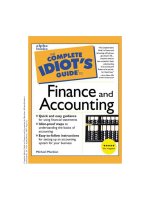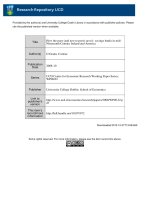Bond Prices and Yields pdf
Bạn đang xem bản rút gọn của tài liệu. Xem và tải ngay bản đầy đủ của tài liệu tại đây (916.08 KB, 47 trang )
Chapter
McGraw-Hill/Irwin
Copyright © 2008 by The McGraw-Hill Companies, Inc. All rights reserved.
Bond Prices and Yields
10-2
Bond Prices and Yields
• Our goal in this chapter is to understand the relationship
between bond prices and yields.
• In addition, we will examine some fundamental tools that
fixed-income portfolio managers use when they assess
bond risk.
10-3
Bond Basics, I.
•AStraight bond is an IOU that obligates the issuer of the
bond to pay the holder of the bond:
– A fixed sum of money (called the principal, par value, or face
value) at the bond’s maturity, and sometimes
– Constant, periodic interest payments (called coupons) during the
life of the bond
• U.S. Treasury bonds are straight bonds.
• Special features may be attached
– Convertible bonds
– Callable bonds
– Putable bonds
10-4
Bond Basics, II.
• Two basic yield measures for a bond are its
coupon rate and its current yield.
value Par
coupon Annual
rate Coupon =
price Bond
coupon Annual
yieldCurrent =
10-5
Straight Bond Prices and Yield to Maturity
• The price of a bond is found by adding together the
present value of the bond’s coupon payments and
the present value of the bond’s face value.
•The Yield to maturity (YTM) of a bond is the discount
rate that equates the today’s bond price with the present
value of the future cash flows of the bond.
10-6
The Bond Pricing Formula
• The price of a bond is found by adding together the present
value of the bond’s coupon payments and the present value of
the bond’s face value.
• The formula is:
• In the formula, C represents the annual coupon payments (in $), FV
is the face value of the bond (in $), and M is the maturity of the bond,
measured in years.
()()
2M2M
2
YTM
1
FV
2
YTM
1
1
1
YTM
C
PriceBond
+
+
⎥
⎥
⎥
⎦
⎤
⎢
⎢
⎢
⎣
⎡
+
−=
10-7
Example: Using the Bond Pricing Formula
• What is the price of a straight bond with: $1,000 face
value, coupon rate of 8%, YTM of 9%, and a maturity of
20 years?
()()
()()
$907.99.
171.93 0.82807)(888.89
2
0.09
1
1000
2
0.09
1
1
1
0.09
80
PriceBond
2
YTM
1
FV
2
YTM
1
1
1
YTM
C
PriceBond
0202
2M2M
=
+×=
+
+
⎥
⎥
⎥
⎦
⎤
⎢
⎢
⎢
⎣
⎡
+
−=
+
+
⎥
⎥
⎥
⎦
⎤
⎢
⎢
⎢
⎣
⎡
+
−=
×× 22
10-8
Example: Calculating the Price of
this Straight Bond Using Excel
• Excel has a function that allows you to price straight bonds, and it is
called PRICE.
=PRICE(“Today”,“Maturity”,Coupon Rate,YTM,100,2,3)
• Enter “Today” and “Maturity” in quotes, using mm/dd/yyyy format.
• Enter the Coupon Rate and the YTM as a decimal.
• The "100" tells Excel to us $100 as the par value.
• The "2" tells Excel to use semi-annual coupons.
• The "3" tells Excel to use an actual day count with 365 days per year.
Note: Excel returns a price per $100 face.
10-9
Premium and Discount Bonds, I.
• Bonds are given names according to the relationship
between the bond’s selling price and its par value.
• Premium bonds: price > par value
YTM < coupon rate
• Discount bonds: price < par value
YTM > coupon rate
• Par bonds: price = par value
YTM = coupon rate
10-10
Premium and Discount Bonds, II.
10-11
Premium and Discount Bonds, III.
• In general, when the coupon rate and YTM are held
constant:
for premium bonds: the longer the term to maturity, the
greater the premium over par value.
for discount bonds: the longer the term to maturity, the
greater the discount from par value.
10-12
Relationships among Yield Measures
for premium bonds:
coupon rate > current yield > YTM
for discount bonds:
coupon rate < current yield < YTM
for par value bonds:
coupon rate = current yield = YTM
10-13
Calculating Yield to Maturity, I.
• Suppose we know the current price of a bond, its coupon rate, and
its time to maturity. How do we calculate the YTM?
• We can use the straight bond formula, trying different yields until we
come across the one that produces the current price of the bond.
• This is tedious. So, to speed up the calculation, financial calculators
and spreadsheets are often used.
()()
2020 ××
+
+
⎥
⎥
⎥
⎦
⎤
⎢
⎢
⎢
⎣
⎡
+
−=
22
2
YTM
1
$1,000
2
YTM
1
1
1
YTM
$80
$907.99
10-14
Calculating Yield to Maturity, II.
• We can use the YIELD function in Excel:
=YIELD(“Today”,“Maturity”,Coupon Rate,Price,100,2,3)
• Enter “Today” and “Maturity” in quotes, using mm/dd/yyyy format.
• Enter the Coupon Rate as a decimal.
• Enter the Price as per hundred dollars of face value.
• Note: As before,
– The "100" tells Excel to us $100 as the par value.
– The "2" tells Excel to use semi-annual coupons.
– The "3" tells Excel to use an actual day count with 365 days per
year.
• Using dates 20 years apart, a coupon rate of 8%, a price (per
hundred) of $90.80, give a YTM of 0.089999, or 9%.
10-15
A Quick Note on Bond Quotations, I.
• We have seen how bond prices are quoted in the
financial press, and how to calculate bond prices.
• Note: If you buy a bond between coupon dates, you will
receive the next coupon payment (and might have to pay
taxes on it).
• However, when you buy the bond between coupon
payments, you must compensate the seller for any
accrued interest.
10-16
A Quick Note on Bond Quotations, II.
• The convention in bond price quotes is to ignore accrued
interest.
– This results in what is commonly called a clean price (i.e., a
quoted price net of accrued interest).
– Sometimes, this price is also known as a flat price.
• The price the buyer actually pays is called the dirty price
– This is because accrued interest is added to the clean price.
– Note: The price the buyer actually pays is sometimes known as
the full price, or invoice price.
10-17
Callable Bonds
• Thus far, we have calculated bond prices assuming that
the actual bond maturity is the original stated maturity.
• However, most bonds are callable bonds.
•A callable bond gives the issuer the option to buy back
the bond at a specified call price anytime after an initial
call protection period.
• Therefore, for callable bonds, YTM may not be useful.
10-18
Yield to Call
• Yield to call (YTC) is a yield measure that assumes a bond will be
called at its earliest possible call date.
• The formula to price a callable bond is:
• In the formula, C is the annual coupon (in $), CP is the call price of
the bond, T is the time (in years) to the earliest possible call date,
and YTC is the yield to call, with semi-annual coupons.
• As with straight bonds, we can solve for the YTC, if we know the
price of a callable bond.
()()
2T2T
2
YTC
1
CP
2
YTC
1
1
1
YTC
C
Price Bond Callable
+
+
⎥
⎥
⎥
⎦
⎤
⎢
⎢
⎢
⎣
⎡
+
−=
10-19
Interest Rate Risk
• Holders of bonds face Interest Rate Risk.
• Interest Rate Risk is the possibility that changes in
interest rates will result in losses in the bond’s value.
• The yield actually earned or “realized” on a bond is called
the realized yield.
• Realized yield is almost never exactly equal to the yield
to maturity, or promised yield.
10-20
Interest Rate Risk and Maturity
10-21
Malkiel’s Theorems, I.
c Bond prices and bond yields move in opposite directions.
– As a bond’s yield increases, its price decreases.
– Conversely, as a bond’s yield decreases, its price increases.
d For a given change in a bond’s YTM, the longer the term
to maturity of the bond, the greater the magnitude of the
change in the bond’s price.
10-22
Malkiel’s Theorems, II.
e For a given change in a bond’s YTM, the size of the
change in the bond’s price increases at a diminishing rate
as the bond’s term to maturity lengthens.
f For a given change in a bond’s YTM, the absolute
magnitude of the resulting change in the bond’s price is
inversely related to the bond’s coupon rate.
g For a given absolute change in a bond’s YTM, the
magnitude of the price increase caused by a decrease in
yield is greater than the price decrease caused by an
increase in yield.
10-23
Bond Prices and Yields
10-24
Duration
• Bondholders know that the price of their bonds change when interest
rates change. But,
– How big is this change?
– How is this change in price estimated?
• Macaulay Duration, or Duration, is the name of concept that helps
bondholders measure the sensitivity of a bond price to changes in
bond yields. That is:
Î Two bonds with the same duration, but not necessarily the same
maturity, will have approximately the same price sensitivity to a
(small) change in bond yields.
()
2
YTM
1
YTMin Change
DurationPrice Bond in Change Pct.
+
×−≈
10-25
Example: Using Duration
• Example: Suppose a bond has a Macaulay Duration of 11 years,
and a current yield to maturity of 8%.
• If the yield to maturity increases to 8.50%, what is the resulting
percentage change in the price of the bond?
()
[]
()
-5.29%.
2
0.08
1
0.080.085
11- Price Bond in Change Pct.
≈
+
−
×≈









